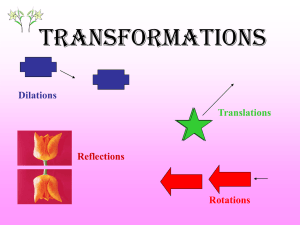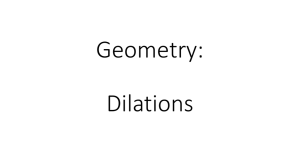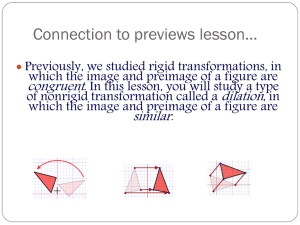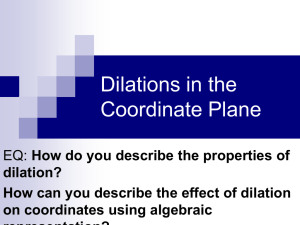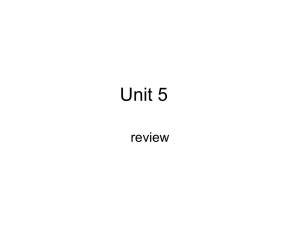3 transformations
advertisement
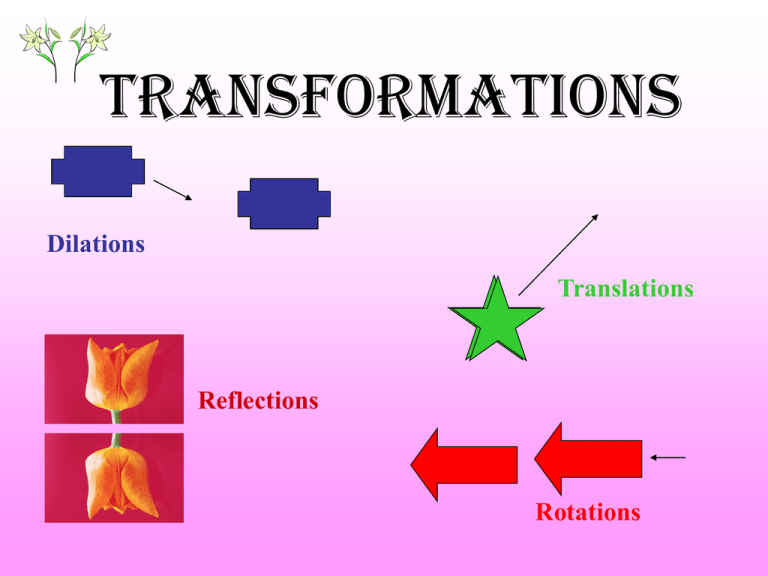
Transformations Dilations Translations Reflections Rotations Reflections in a line • Reflections in a line are like mirror images. • They stay the same size and shape, but they flip! • In geometry, reflections of figures may be on a coordinate plane. Reflections in a line • Reflections can be made across the x-axis. x-axis Look at the corresponding points in the figures. The point (-4, 4) corresponds to the image point (-4, -4). The point (2, 4) corresponds to (2, -4). Notice that in a reflection over the x-axis, the coordinates of the x’s stay the same but the y’s change sign. In a reflection across the x-axis, the point (x, y) reflects onto image (x, -y). Reflections in the y axis • Reflections can be made across the y-axis. y-axis Check the corresponding points here. Notice that the point (2, 1) corresponds to (-2, 1). The point (7, 1) corresponds to (-7, 1). The y values stay the same, but the x values change sign. In a reflection across the y axis, the point (x, y) reflects onto image (-x, y). Reflections in other lines . . . • Let’s look at what happens if you reflect a figure across the line y = x or line y = -x y=x Look at corresponding points. Notice that for (x, y), the corresponding image point is (y, x). For (-2, 5), image point is (5, -2). y = -x Look at corresponding points. Notice that for (x, y), the corresponding image point is (-y, -x). For (6, 3), image point is (-3, -6) Reflections in more lines . . . • What happens if you reflect in a line y = 3? or x = -2 ? y=3 x = -2 Each point and corresponding image must be equidistant from the line. Note (4, 2) and image point (4, 4) are each 1 unit from the line y = 3. Each point and corresponding image must be equidistant from the line. Note (0, 4) and image point (-4, 4) are 2 units from the line x = -2. Check it out ! See how you can do with these problems. Find the image point for each reflection given the point and the line of reflection: a. Point (5, -2), reflected in the x axis b. Point (- 4, 3), reflected in the line y = x c. Point (-1, -6), reflected in the y axis d. Point (2, 4), reflected in the line y = 1 e. Point (-3, 5), reflected in the line x = 3 f. Point (4, 7) reflected in the y axis Answers: a. (5, 2) b. (3, - 4) c. (1, - 6) d. (2, -2) e. ( 9, 5) f. (-4, 7) Translations (or slides) • Figures which are transformed by “sliding” from one place to another without change to size, shape, or direction illustrate “translation”. Notice all the faces are the same. They just move around the page! Let’s move some things! • When we slide or translate figures, nothing changes except the location. • In the figure to the right, triangle A slides 7 units to the right and 4 units down to the image position A’. Each vertex of the triangle makes that move. AA’ We can explain the translation in several ways. 1. Describe it in words: “ Move the figure 7 units right and 4 units down.” 2. Use symbols: Using T (for transition) and a coordinate pair to represent the right/left move and then the up/down move , write T(7, -4). 3. Show a mapping: (x, y ) (x + 7, y – 4) Check it out . . . . 1. Under translation T(-3, 2), what will the point (4, 5) become? 2. Under translation (x, y) (x+1, y-4), what will (2, 5) become? 3. Under the translation of 4 units up and 3 unit left, what will (5, -1) become? 4. Rectangle ABCD with vertices shown is translated under T(-2, 1). Find the vertices of rectangle A’B’C’D’. A(1, 7) A’( , ) C(1, 2) C’( , ) B(6, 7) B’ ( , ) D(6, 2) D’( , ) 5. ΔABC with vertices shown below is translated to ΔA’B’C’. A(4, 7), B (1, 0), C ( , ) A’(1, 5), B’ ( , ), C’(4, 0) a. What translation is being used here? b. Find the coordinates of point C. c. Find the coordinates of point B’. (continued on next slide) Keep it going . . . . B a. A A’ c . C b. A D 7. 6. a. Is this a translation? b. Is this a translation? c. Is this a translation? a. What point is the image of B under T(7, -10)? b. What point is the image of D under T (-5, 4)? c. What point is the image of C under T(7, 4)? 8. What translation is used in the figures above? 9. If point A(-3, 1) is translated under T(2, -3), followed by T(5, 1), followed by T (-1, 6), what single translation would have given the same result? Answers: 1. (1, 7) 5. a. T(-3, -2), 7. a. D, b. C, 2. (3, 1) b. C(7, 2), c. A 3. (2, 3) c. B’(-2, -2) A8. T(6, 3) 4. A’(-1, 8), B’(4, 8), C’(-1, 3), D’(4, 3) 6. a. no. b. yes c. no 9. T (6, 4) Dilations • A dilation is a non-rigid transformation that results in an image that is the same shape as the original but is either smaller or larger. Every image is similar to its pre-image. With dilations, the corresponding angles stay the same. 9 12 A 15 3 4 A’ 5 • Corresponding linear measures (length, width, radius, etc.) are proportional. Their ratios all reduce to the same value. • The corresponding sides above create the following ratios: 5 4 3 1 , , and which all reduce to . 15 12 9 3 Since all sides of the first triangle can be multiplied by 1/3 (or divided by 3) to get the measures of the second triangle, the value 1/3 is called a scale factor of the dilation. Scale factors and centers . . . • Dilations use a scale factor to describe the size change from the original to the image. It represents the ratio of the lengths of the sides of the two figures. • A center is also part of the dilation process. In coordinate geometry, this is usually, but not always, the origin (0, 0). •Here’s a sample dilation where the smaller green rectangle has a dilation image, the red rectangle, with center at (0, 0), and a scale factor of 2. A(-2, 1) B(2, 1) D’ •Notice that all of the coordinates of the red rectangle are 2 times those of the green rectangle. B’ A’ A B D C C(2 -1) D(-2,-1) A’(-4. 2) C’ B’(4, 2) C’(4, -2) D’(-4, -2) . Dilations and notation . . . • A dilation with scale factor “k” and center at (0,0) may be expressed as Dk(x,y) = (kx, ky). If the scale factor is between 0 and 1, the image will be smaller than the original, or a reduction. Scale factor = 3/4 If the scale factor is greater than 1, the image will be larger than the original, or an enlargement. Scale factor = 2 A dilation with center at (0, 0) and a scale factor of 2/3. . . • In this dilation, notice the center is (0, 0) and the sides of the image in red are 2/3 the lengths of the original figure in blue. • Since the scale factor is less than 1, the image (red) is a reduction of the original figure (blue). Dilations with center not at (0, 0) • If the center is not at (0, 0), be careful to check the lengths of the sides of the figures to conform to the scale factor. A The center of the dilation is at point A. The original figure is the red rectangle, and the image is the green rectangle. The scale factor must be 2 since each of the sides of the image (green) is 2 times the length of the sides of the original figure (red). Check it out . . . • 1. A rectangle has vertices (3, 4), (9, 4), (3, 7), and (9, 7). If it is dilated with center (0, 0) and a scale factor of 2, what will be the vertices of the image? • 2. If a triangle with vertices (3, 6), (9, 3), and (12, 15) dilates with center at (0,0) and a scale factor of 2/3, what are the vertices of the image? C B D A 3. If rectangle ABCD is dilated with center (0,0), and a scale factor of 2, what are the coordinates of the B’ of the image? 4. If triangle shown is dilated with center (0, 0) and scale factor of 1/3, give the coordinates of the image. 5. If a triangle with vertices (2, 3), (1, 6), and (-2, 4) is dilated with center at (0, 0) and its image has vertices (8, 12), (4, 24), and (-8, 14), what is the scale factor? Answers: 1. (6, 8), (18, 8), (6, 14), (18, 14) 4. (1, 0), (0, -2), (2, -2) 5. scale factor = 4 2. (2, 4), (6, 2), (8, 10) 3. (-2, 8) Review from a “view” – reflections – translations - dilations • What is the transformation shown? There may be two transformations for some of the figures. Answers: top, left to right: translation; dilation; reflection over y-axis bottom, left to right: 2 reflections (over x-axis, then over y-axis) ; reflection over y-axis; reflection over x-axis and then translation Rotations • Another form of a transformation is called a “rotation.” • In a rotation, the figure stays the same size and shape, but turns clockwise or counterclockwise. Rotations around the origin • Let’s draw a picture and rotate it counter-clockwise 90° around the origin (0, 0). D’ A’ A B D C’ B’ C You can use patty paper to trace the figure and the x and y axes. Rotate it counter clockwise 90°. (Use the x and y axes to help. Line the axes up with 90° rotation and then trace the image.) Look where the vertices land for the rotated image. Original: A( 4,6), Image: B(-1, 4), A’(-6, 4), B’(-4, -1), C( 2, 1), D( 5, 3) C’(-1, 2), D’(-3, 5) Compare the coordinates of the image points. What do you see? How could you describe the relationship between original and image points? Keep it “rolling” . . . . • We rotated the figure 90°. Look what happens if we rotate 90° counterclockwise again (blue figure), and then one more time (turqoise figure). That makes rotations of 90°, 180°, and 270°. A D’ B A’ 90° D’’ B’ B’’’D C’ C’’ 180° A’’ Original C 270° B’’ D’’’ A’’’ Check out the coordinates this time. Original: Image A’: Image A’’: A( 4,6) A’(-6, 4) A’’(-4, -6) B(-1, 4) B’(-4, -1) B’’(1, -4) C( 2, 1) C’(-1, 2) C’’(-2, -1) D( 5, 3) D’(-3, 5) D’’(-5, -3) Image A’’’ A’’’( 6,-4) B’’’( 4, 1) C’’’( 1, -2) D’’’( 3, -5) Do you see a pattern for the coordinates? For each 90° rotation in order, the corresponding coordinates change by switching the x and y, then change the sign of the first coordinate. Rotations wherever! • If you want to rotate a figure 90°, 180°, or 270°, just use patty paper to trace the figure and a horizontal and vertical reference line. You can use a point on the figure as your rotation point. It doesn’t have to be the origin. • Rotate the lines to whatever angle you want, then retrace the figure onto the paper. Use the horizontal and vertical lines to help you The red trapezoid was rotated 90° about the point shown, not the origin. . The triangular figure was rotated to all the positions , 90°, 180°, 270°, and back to the original at 360°. This rotation was about the point shown. Transformation review! A quick look at the types of transformations we’ve seen . . . • 1. Reflections: the figure maintains the same size and shape but is a mirror-image of itself 2. Translations: the figure maintains the same size and shape, but moves to a new location by “sliding.” Transformation review! • 3. Dilations: the figure maintains the same shape but grows or shrinks (angles stay the same, corresponding sides are proportional). 4. Rotations: the figure keeps its size and shape but turns.
